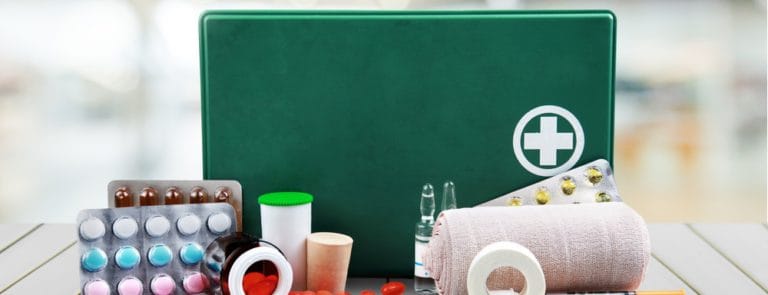20% off €35
20 things you must have in your first aid kit

So, you’ve accidentally cut your hand and all you can find is some out-of-date antiseptic cream and a plaster that’s seen better days….
If this sounds like a familiar scene in your household, it may be time to stock up on your list of first aid essentials. Take a look at our handy checklist and be prepared for any at-home emergencies.
Why are first aid kits important?
Every year in the UK, thousands of people die or are seriously injured in incidents. According to the NHS, many deaths could be prevented if first aid was given before the emergency services arrive.
If you find yourself in a situation where somebody’s become injured or you happen to come across someone who’s injured, you should:
- Check you/they aren’t in any immediate danger.
- If you can, try and make the situation as safe as possible for everybody involved.
- Dial 999 or 112 for an ambulance if you are involved in an emergency situation.
- Carry out basic first aid until an ambulance arrives.
Contents of a first aid kit
What things should be in a first aid kit?
Most first aid kits are green boxes with a white cross on the front. All homes, cars, leisure centres and workplaces should have first aid kits to hand.1
Basic first aid kit contents include: sterile dressings, bandages, protective items and additional items, including cleansing wipes, gauze pads, adhesive tape, scissors, pins and clips and an aluminium blanket.2
More specifically, workplace first aid boxes should, according to HSE guidance, contain basic first aid instructions, sterile plasters and eye pads, triangular bandages, safety pins, large and medium-sized unmedicated wound dressings and disposable gloves.3
What is not allowed in a first aid kit?
Your first aid box shouldn’t contain any items that are out of date or no longer in a state to be used, e.g. they’re no longer sterile or have become soiled or damp for whatever reason.4
First aid kits shouldn’t contain any types of tablets or medication either. If your first aid box contains sterile water or sterile normal saline (0.9%) and the seal is broken, the water should be disposed of and the containers shouldn’t be reused.
What you mustn’t forget about your first aid kit…
Lots of people get themselves a first aid kit and use it from time-to-time or not at all. The important thing is not to forget about your first aid box, even if you’ve not used it in a while.
You should keep your first aid kit locked and in a cool, dry place that’s out of reach of children. Ideally, you should replace any items as soon as you’ve used them so they aren’t missing from your kit in an emergency. What’s more, some items within your first aid kit can expire. Items that have passed their expiry date should be disposed and replaced as they may not be effective and can start to deteriorate, making them unsafe.5
First aid kit checklist
- Alcohol-free cleansing wipes
- Antihistamine tablets for allergic reactions
- Antiseptic cream
- Cough medicine
- Crêpe rolled bandages to treat muscle strains and sprains
- Disposable sterile gloves
- A digital thermometer
- Distilled water for cleaning wounds
- Eye wash and eye bath
- Insect bite or sting relief cream
- Painkillers including infant Paracetamol for children
- Plasters in a variety of different sizes and shapes
- Safety pins to secure bandages and slings
- Scissors
- Skin rash cream
- Sterile gauze dressings in a range of sizes
- Medical sticky tape for keeping bandages and dressings in place
- Triangular bandages used as slings to support arm injuries
- Tweezers
- Two sterile eye dressings
Now you’ve gathered your kit, you’re prepared to care for your family’s first aid needs.
Remember to store your kit in a cool, dry place that’s out of reach of children, taking care to check use-by dates. You may also find it handy to keep a basic first aid manual to hand, so you’re able to swiftly tend to any minor injuries or ailments.
Last updated: 7 May 2021
- https://www.sja.org.uk/get-advice/i-need-to-know/what-to-put-in-a-first-aid-kit/
- https://www.sja.org.uk/get-advice/i-need-to-know/what-to-put-in-a-first-aid-kit/
- https://www.hse.gov.uk/firstaid/faqs.htm
- https://worksmart.org.uk/health-advice/employer-support/first-aid/what-should-first-aid-box-contain
- https://www.sja.org.uk/get-advice/i-need-to-know/Do-first-aid-kits-expire/



